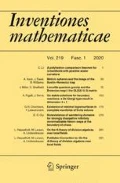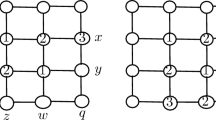Abstract
A proper q-coloring of a domain in \({\mathbb {Z}}^d\) is a function assigning one of q colors to each vertex of the domain such that adjacent vertices are colored differently. Sampling a proper q-coloring uniformly at random, does the coloring typically exhibit long-range order? It has been known since the work of Dobrushin that no such ordering can arise when q is large compared with d. We prove here that long-range order does arise for each q when d is sufficiently high, and further characterize all periodic maximal-entropy Gibbs states for the model. Ordering is also shown to emerge in low dimensions if the lattice \({\mathbb {Z}}^d\) is replaced by \({\mathbb {Z}}^{d_1}\times {\mathbb {T}}^{d_2}\) with \(d_1\ge 2\), \(d=d_1+d_2\) sufficiently high and \({\mathbb {T}}\) a cycle of even length. The results address questions going back to Berker and Kadanoff (in J Phys A Math Gen 13(7):L259, 1980), Kotecký (in Phys Rev B 31(5):3088, 1985) and Salas and Sokal (in J Stat Phys 86(3):551–579, 1997).







Similar content being viewed by others
Notes
Note that every coloring in \(\Omega ^{\text {free}}_{[n]^d}\) may be extended to a proper coloring of all of \({\mathbb {Z}}^d\), e.g., by iterated reflections (similarly to Fig. 7A).
References
Alon, N., Briceño, R., Chandgotia, N., Magazinov, A., Spinka, Y.: Mixing properties of colourings of the \({{ Z}}^{d}\) lattice. Comb. Probab. Comput. 30(3), 360–373 (2021)
Balister, P., Bollobás, B.: Counting regions with bounded surface area. Commun. Math. Phys. 273(2), 305–315 (2007)
Banavar, J.R., Grest, G.S., Jasnow, D.: Ordering and phase transitions in antiferromagnetic Potts models. Phys. Rev. Lett. 45(17), 1424–1428 (1980)
Berker, A.N., Kadanoff, L.P.: Ground-state entropy and algebraic order at low temperatures. J. Phys. A Math. Gen. 13(7), L259 (1980)
Bollobás, B.: The Art of Mathematics: Coffee Time in Memphis. Cambridge University Press, Cambridge (2006)
Brightwell, G.R., Winkler, P.: Random colorings of a Cayley tree. Contemp. Comb. 10, 247–276 (2002)
Burton, R.M., Steif, J.E.: Quite weak Bernoulli with exponential rate and percolation for random fields. Stoch. Process. Appl. 58(1), 35–55 (1995)
Chung, F.R.K., Graham, R.L., Frankl, P., Shearer, J.B.: Some intersection theorems for ordered sets and graphs. J. Comb. Theory Ser. A 43(1), 23–37 (1986)
Dobrushin, R.L.: The description of a random field by means of conditional probabilities and conditions of its regularity. Theor. Probab. Appl. 13, 197–224 (1968)
Dobrushin, R.L.: The problem of uniqueness of a Gibbsian random field and the problem of phase transitions. Funct. Anal. Appl. 2(4), 302–312 (1968)
Engbers, J., Galvin, D.: H-coloring tori. J. Comb. Theory Ser. B 102(5), 1110–1133 (2012)
Engbers, J., Galvin, D.: H-colouring bipartite graphs. J. Comb. Theory Ser. B 102(3), 726–742 (2012)
Feldheim, O.N., Spinka, Y.: The growth constant of odd cutsets in high dimensions. Comb. Probab. Comput. 27, 1–20 (2017)
Feldheim, O.N., Spinka, Y.: Long-range order in the 3-state antiferromagnetic Potts model in high dimensions. J. Eur. Math. Soc. 21(5), 1509–1570 (2019)
Feldheim, O.N., Peled, R.: Rigidity of 3-colorings of the discrete torus. Inst. Henri Poincaré. Ann. l’inst. Henri Poincaré Probab. Stat. 54, 952–994 (2018)
Fernández, R., Fröhlich, J., Sokal, A.D.: Random Walks, Critical Phenomena, and Triviality in Quantum Field Theory. Springer, Berlin (2013)
Friedli, S., Velenik, Y.: Statistical Mechanics of Lattice Systems: A Concrete Mathematical Introduction. Cambridge University Press, Cambridge (2017)
Gallavotti, G., Miracle-Solé, S.: Equilibrium states of the Ising model in the two-phase region. Phys. Rev. B 5(7), 2555 (1972)
Galvin, D.: On homomorphisms from the Hamming cube to \({{ Z}}\). Isr. J. Math. 138, 189–213 (2003). https://doi.org/10.1007/BF02783426
Galvin, D.: Bounding the partition function of spin-systems. Electron. J. Comb. 13(1), 72 (2006)
Galvin, D.: Sampling 3-colourings of regular bipartite graphs. Electron. J. Probab 12, 481–497 (2007)
Galvin, D.: Sampling independent sets in the discrete torus. Random Struct. Algorithms 33(3), 356–376 (2008)
Galvin, D., Kahn, J.: On phase transition in the hard-core model on \({{ Z}}^{d}\). Comb. Probab. Comput. 13(02), 137–164 (2004)
Galvin, D., Kahn, J., Randall, D., Sorkin, G.: Phase coexistence and torpid mixing in the 3-coloring model on \({{ Z}}^{d}\). SIAM J. Discrete Math. 29(3), 1223–1244 (2015)
Galvin, D., Randall, D.: Torpid mixing of local Markov chains on 3-colorings of the discrete torus. In: Society for Industrial and Applied Mathematics, bookProceedings of the Eighteenth Annual ACM-SIAM symposium on Discrete Algorithms, pp. 376–384 (2007)
Galvin, D., Tetali, P.: On weighted graph homomorphisms. DIMACS Ser. Discrete Math. Theor. Comput. Sci. 63, 97–104 (2004)
Galvin, D., Tetali, P.: Slow mixing of Glauber dynamics for the hard-core model on the hypercube. In: Society for Industrial and Applied Mathematics, Book Proceedings of the 15th Annual ACM-SIAM Symposium on Discrete Algorithms, pp. 466–467 (2004)
Galvin, D., Tetali, P.: Slow mixing of Glauber dynamics for the hard-core model on regular bipartite graphs. Random Struct. Algorithm 28(4), 427–443 (2006)
Georgii, H.-O.: Gibbs Measures and Phase Transitions, vol. 9. Walter de Gruyter, Berlin (2011)
Goldberg, L.A., Martin, R., Paterson, M.: Strong spatial mixing with fewer colors for lattice graphs. SIAM J. Comput. 35(2), 486–517 (2005)
Huang, Y., Chen, K., Deng, Y., Jacobsen, J.L., Kotecký, R., Salas, J., Sokal, A.D., Swart, J.M.: Two-dimensional Potts antiferromagnets with a phase transition at arbitrarily large \(q\). Phys. Rev. E 87(1), 012136 (2013)
Jonasson, J.: Uniqueness of uniform random colorings of regular trees. Stat. Probab. Lett. 57(3), 243–248 (2002)
Kahn, J.: An entropy approach to the hard-core model on bipartite graphs. Comb. Probab. Comput. 10(03), 219–237 (2001)
Kahn, J.: Range of cube-indexed random walk. Isr. J. Math. 124, 189–201 (2001). https://doi.org/10.1007/BF02772616
Kahn, J., Lawrenz, A.: Generalized rank functions and an entropy argument. J. Comb. Theory Ser. A 87(2), 398–403 (1999)
Kahn, J., Park, J.: The number of 4-colorings of the Hamming cube. Isr. J. Math. 236, 1–21 (2020)
Korshunov, A.D.: On the number of monotone Boolean functions. Probl. Kibern. 38, 5–108 (1981)
Korshunov, A.D., Sapozhenko, A.A.: The number of binary codes with distance 2. Probl. Kibern. 40(1), 111–130 (1983). (Russian)
Kotecký, R.: Long-range order for antiferromagnetic Potts models. Phys. Rev. B 31(5), 3088 (1985)
Kotecký, R., Sokal, A.D., Swart, J.M.: Entropy-driven phase transition in low-temperature antiferromagnetic Potts models. Commun. Math. Phys. 330(3), 1339–1394 (2014)
Lanford, O.E., Ruelle, D.: Observables at infinity and states with short range correlations in statistical mechanics. Commun. Math. Phys. 13(3), 194–215 (1969)
Lebowitz, J.L., Mazel, A.E.: Improved Peierls argument for high-dimensional Ising models. J. Stat. Phys. 90(3–4), 1051–1059 (1998). https://doi.org/10.1023/A:1023205826704
Lovász, L.: On the ratio of optimal integral and fractional covers. Discrete Math. 13(4), 383–390 (1975)
Lubensky, T.C., Isaacson, J.: Statistics of lattice animals and dilute branched polymers. Phys. Rev. A 20(5), 2130 (1979)
Lubetzky, E., Zhao, Y.: On replica symmetry of large deviations in random graphs. Random Struct. Algorithms 47(1), 109–146 (2015)
Madiman, M., Tetali, P.: Information inequalities for joint distributions, with interpretations and applications. IEEE Trans. Inf. Theory 56(6), 2699–2713 (2010)
McEliece, R.: The Theory of Information and Coding, vol. 3. Cambridge University Press, Cambridge (2002)
Meyerovitch, T., Pavlov, R.: On independence and entropy for high-dimensional isotropic subshifts. Proc. Lond. Math. Soc. 109, 921–945 (2014)
Misiurewicz, M.: A short proof of the variational principle for a \({{ Z}}_+^{N}\)-action on a compact space. Astérisque 40, 147–157 (1975)
Peierls, R.: On Ising’s model of ferromagnetism. In: Mathematical Proceedings of the Cambridge Philosophical Society, vol. 32, pp. 477–481. Cambridge University Press (1936)
Peled, R.: High-dimensional Lipschitz functions are typically flat. Ann. Probab. 45(3), 1351–1447 (2017)
Peled, R., Samotij, W.: Odd cutsets and the hard-core model on \({{\bf Z}}^{d}\). Inst. Henri Poincaré Ann. l’inst. Henri Poincaré Probab. Stat. 50, 975–998 (2014)
Peled, R., Spinka, Y.: A condition for long-range order in discrete spin systems with application to the antiferromagnetic Potts model (2017). arXiv preprint arXiv:1712.03699
Peled, R., Spinka, Y.: Long-range order in discrete spin systems (2020). arXiv preprint arXiv:2010.03177
Pirogov, S.A., Sinai, Y.G.: Phase diagrams of classical lattice systems. Theor. Math. Phys. 25(3), 1185–1192 (1975)
Pirogov, S.A., Sinai, Y.G.: Phase diagrams of classical lattice systems continuation. Theor. Math. Phys. 26(1), 39–49 (1976)
Qin, M.P., Chen, Q.N., Xie, Z.Y., Chen, J., Yu, J.F., Zhao, H.H., Normand, B., Xiang, T.: Partial long-range order in antiferromagnetic Potts models. Phys. Rev. B 90(14), 144424 (2014)
Rahman, S., Rush, E., Swendsen, R.H.: Intermediate-temperature ordering in a three-state antiferromagnetic Potts model. Phys. Rev. B 58(14), 9125 (1998)
Salas, J., Sokal, A.D.: Absence of phase transition for antiferromagnetic Potts models via the Dobrushin uniqueness theorem. J. Stat. Phys. 86(3), 551–579 (1997)
Sapozhenko, A.A.: The number of antichains in ranked partially ordered sets. Diskretn. Mat. 1(1), 74–93 (1989)
Sapozhenko, A.A.: On the number of connected subsets with given cardinality of the boundary in bipartite graphs, Metody Diskretnogo. Analiza 45, 42–70 (1987). (Russian)
Sapozhenko, A.A.: On the number of antichains in multilevelled ranked posets. Appl. Discrete Math. 1(2), 149–170 (1991)
Slade, G.: Lattice trees, percolation and super-Brownian motion. In: Perplexing Problems in Probability: Festschrift in Honor of Harry Kesten, Basel (1999)
Slade, G.: The Lace Expansion and Its Applications: Ecole d’eté de Probabilités de Saint-Flour xxxiv-2004. Springer, Berlin (2006)
Timár, Á.: Boundary-connectivity via graph theory. Proc. Am. Math. Soc. 141(2), 475–480 (2013)
Vigoda, E.: Improved bounds for sampling colorings. J. Math. Phys. 41(3), 1555–1569 (2000)
Acknowledgements
We thank Raimundo Briceño, Nishant Chandgotia, Ohad Feldheim and Wojciech Samotij for early discussions on proper colorings and other graph homomorphisms. We are grateful to Christian Borgs for valuable advice on the way to present the material of this paper and its companion [54]. We thank Michael Aizenman, Jeff Kahn, Eyal Lubetzky, Dana Randall, Alan Sokal, Prasad Tetali and Peter Winkler for useful discussions and encouragement. The presentation benefited significantly from the insightful comments of three anonymous referees.
Author information
Authors and Affiliations
Corresponding author
Additional information
Publisher's Note
Springer Nature remains neutral with regard to jurisdictional claims in published maps and institutional affiliations.
Research of both authors was supported by the Israel Science Foundation Grant 861/15 and the European Research Council starting Grant 678520 (LocalOrder). Research of Y.S. was additionally supported by the Adams Fellowship Program of the Israel Academy of Sciences and Humanities.
Rights and permissions
Springer Nature or its licensor (e.g. a society or other partner) holds exclusive rights to this article under a publishing agreement with the author(s) or other rightsholder(s); author self-archiving of the accepted manuscript version of this article is solely governed by the terms of such publishing agreement and applicable law.
About this article
Cite this article
Peled, R., Spinka, Y. Rigidity of proper colorings of \({\mathbb {Z}}^{d}\). Invent. math. 232, 79–162 (2023). https://doi.org/10.1007/s00222-022-01164-3
Received:
Accepted:
Published:
Issue Date:
DOI: https://doi.org/10.1007/s00222-022-01164-3



